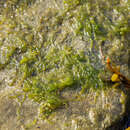Comprehensive Description
provided by Smithsonian Contributions to Botany
Ulva intestinalis Linnaeus
Ulva intestinalis Linnaeus, 1753:1163; Linnaeus, 1755:418; Blomster et al., 1998:332, figs. 49 (typotype), 52–54; Hayden et al., 2003:289, tbl. 4; Hayden and Waaland, 2004:377, tbl. 3; Pedroche et al., 2005:27; Mateo-Cid et al., 2006:48; Pacheco-Ruíz et al., 2008:191, 201.
Enteromorpha intestinalis (Linnaeus) Link in Nees, 1820:Index [2], 5; Howe, 1911:490; Setchell and Gardner, 1920b:252; Dawson, 1944:203; Dawson, 1961b:373; Dawson, 1962c:278; Bliding, 1963:139, figs. 87–89; Dawson, 1966a:5; Huerta-Múzquiz and Tirado-Lizárraga, 1970:126; Brusca and Thomson, 1975:42; Norris, 1976a:76, fig. 31; Huerta-Múzquiz, 1978:336, 338; Silva, 1979:340; L. Aguilar-Rosas et al., 1982:61; R. Aguilar-Rosas, 1982:84; Koeman and van den Hoek, 1982a:308, figs. 70–94; Littler and Arnold, 1982:309; L. Aguilar-Rosas and Bertsch, 1983:114, 119; L. Aguilar-Rosas et al., 1985:125; Huerta-Múzquiz and Mendoza-González, 1985:42; Ibarra-Obando and R. Aguilar-Rosas, 1985:96; L. Aguilar-Rosas and Pacheco-Ruíz, 1986:77; Tello-Velazco, 1986:73; L. Aguilar-Rosas and Pacheco-Ruíz, 1989:81; Sánchez-Rodríguez et al., 1989:39; R. Aguilar-Rosas and Machado-Galindo, 1990:188; Dreckmann et al., 1990:24, 37; Rocha-Ramírez and Siqueiros-Beltrones, 1991:30; González-González, 1993:443; Mateo-Cid et al., 1993:51; Stout and Dreckmann, 1993:4; R. Aguilar-Rosas and M. Aguilar-Rosas, 1994:517, 529; Mendoza-González et al., 1994:112; González-González et al., 1996:285; Mendoza-González and Mateo-Cid, 1996:74, 87, pl. 23: figs. 98–101; Anaya-Reyna and Riosmena-Rodríguez, 1996:862; Pacheco-Ruíz and Zertuche-González, 1996a:432; Leskinen and Pamilo, 1997:17; Bucio-Pacheco and Dreckmann, 1998:42; Yoshida, 1998:35; Mendoza-González and Mateo-Cid, 1998:24, 27; Blomster et al., 1998:319, figs. 1–3, 16–26, 27–29, 49, 52–54; Rodríguez-Morales and Siqueiros-Beltrones, 1999:30; L. Aguilar-Rosas et al., 2000:133; León-Tejera and González-González, 2000:327; Paul-Chávez and Riosmena-Rodríguez, 2000:146; Cruz-Ayala et al., 2001:190; Abbott and Huisman, 2004:49, fig. 7A–C; Riosmena-Rodríguez et al., 2005:101; Hernández-Herrera et al., 2005:146; R. Aguilar-Rosas et al. 2005b:35; Dreckmann et al., 2006:153.
Enteromorpha marchantiae Setchell et N. L. Gardner, 1924a:716, pl. 16: figs. 40–42.
Algae usually simple, tubular and smooth throughout (sometimes irregularly inflated and constricted), up to 15 mm in diameter; attenuated toward base, remaining tubular (rarely becoming slightly compressed) and broadening upward; rarely branched. Cells in surface view, irregularly arranged throughout; 5–10 µm wide and 5–12 (–17) µm long; with a single cup-shaped chloroplast and usually 1(–2) pyrenoid(s).
HABITAT. On rocks, occasionally epiphytic on other algae; high to low intertidal; also dredged 4–50 m (Dawson, 1944).
DISTRIBUTION. Gulf of California: Puerto Peñasco to Bahía La Paz. Pacific coast: Alaska to Chiapas; Peru; Chile; Hawaiian Islands; Japan; China.
TYPE LOCALITY. “In Mari omni” (Linnaeus, 1753); probably Woolwich, River Thames, London, England (based on selection of lectotype illustration of Dillenius [1742:pl. 9: fig. 7] and typotype [see Stearn, 1957:129] by Blomster et al. [1999:332, figs. 49, 52–54]).
- bibliographic citation
- Norris, James N. 2010. "Marine algae of the northern Gulf of California : Chlorophyta and Phaeophyceae." Smithsonian Contributions to Botany. 276-276. https://doi.org/10.5479/si.0081024X.94.276
Ulva intestinalis: Brief Summary
provided by wikipedia EN

Large green lumps of Ulva intestinalis floating among other brown algae in
Brofjorden Ulva intestinalis is a green alga in the family Ulvaceae, known by the common names sea lettuce, green bait weed, gutweed, and grass kelp. Until they were reclassified by genetic work completed in the early 2000s, the tubular members of the sea lettuce genus Ulva were placed in the genus Enteromorpha.
- license
- cc-by-sa-3.0
- copyright
- Wikipedia authors and editors



 Large green lumps of Ulva intestinalis floating among other brown algae in Brofjorden
Large green lumps of Ulva intestinalis floating among other brown algae in Brofjorden